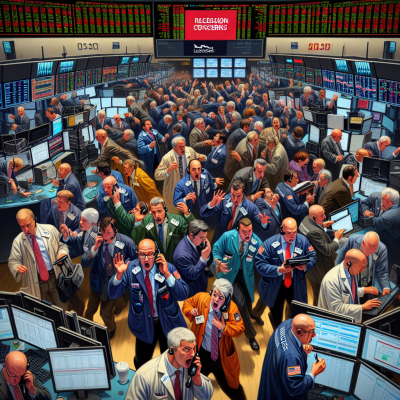
Market Turbulence Sparks Fears of Recession Amid Tariff Tensions
The U.S. stock market faced a fresh wave of turmoil as investors digested the escalating trade conflict between the United States and China. President Donald Trump’s latest defense of tariffs — despite clear market unease — has added fuel to concerns that a prolonged trade war could drive the economy into recession.
Stocks Tumble as Trade War Dominates Wall Street Headlines
Wall Street experienced another jittery session, with the major indexes swinging dramatically. The Dow Jones Industrial Average, S&P 500, and Nasdaq Composite all closed lower as investor anxiety intensified over the impact of the U.S.-China tariff standoff.
- Dow Jones: Struggled for direction before finishing the day with losses.
- S&P 500: Gave up early gains amidst a selloff in the afternoon session.
- Nasdaq: Bearish sentiment among tech and semiconductor stocks weighed down the index.
These sharp moves echoed growing fears that tariffs and retaliatory measures are hurting corporate profits, slowing global growth, and tilting the U.S. toward an economic downturn.
President Trump Sticks to His Tariff Strategy
Speaking in defense of his administration’s aggressive trade policy, President Trump framed tariffs as a tool to rebalance global trade and protect American industries. In a video interview, he dismissed market declines as temporary jitters and attributed the downtrend to a necessary step in enforcing stronger trade terms with countries like China.
“We’re winning on every front,” Trump said, emphasizing that tariffs were bringing billions into the U.S. Treasury. However, many economists and investors argue that the revenue from tariffs comes at the expense of consumers and businesses already struggling with higher costs and supply chain disruptions.
Market Experts Push Back Against White House Optimism
Despite the administration’s upbeat rhetoric, experts across the financial sector are warning of potential long-term consequences. Many point to the following concerns:
- Supply Chain Shifts: Businesses are being forced to reconsider suppliers, often at increased cost.
- Investment Delays: Companies are holding off on expansion plans due to uncertainty.
- Consumer Confidence: Rising prices and volatility may weaken spending.
According to analysts, if tariffs remain in place or broaden further, the risk of a recession will increase significantly by the end of the year.
Global Markets Also Send Warning Signals
It’s not just the U.S. that’s feeling the pinch. Global markets have started flashing similar warning signs. European and Asian markets dipped sharply, and bond yields in multiple countries continued to show signs of stress — often seen as a precursor to economic slowdown.
A particularly worrisome signal came as the U.S. yield curve inverted again, with short-term interest rates surpassing long-term rates — an inversion that has historically preceded recessions.
Federal Reserve Eyes Potential Response
The Federal Reserve has already cut interest rates once this year and is under immense pressure from Wall Street and the White House to consider additional easing measures. However, some Fed officials urge caution, noting that aggressive rate cuts may not be a panacea for structural issues caused by tariff battles and global trade uncertainty.
What’s Next for Markets and the Economy?
Investors are watching closely for any developments that might indicate an easing of tensions between the U.S. and China. However, with no comprehensive trade deal in sight, markets are likely to remain volatile for the foreseeable future.
Takeaways for Investors:
- Stay Diversified: Spreading investments across industries and regions may help mitigate risk.
- Keep an Eye on Indicators: Watch the yield curve, consumer spending trends, and manufacturing data as recession indicators.
- Monitor Policy Changes: Any change in Fed policy or breakthrough in trade negotiations could shift market sentiment swiftly.
Conclusion
As President Trump doubles down on tariffs and global markets react, the economic landscape remains uncertain. While the White House continues to express confidence in its strategy, Wall Street’s volatility reveals investors aren’t entirely convinced. With growing fears of a recession looming on the horizon, the coming months will be critical in shaping America’s economic trajectory.


Leave a Reply